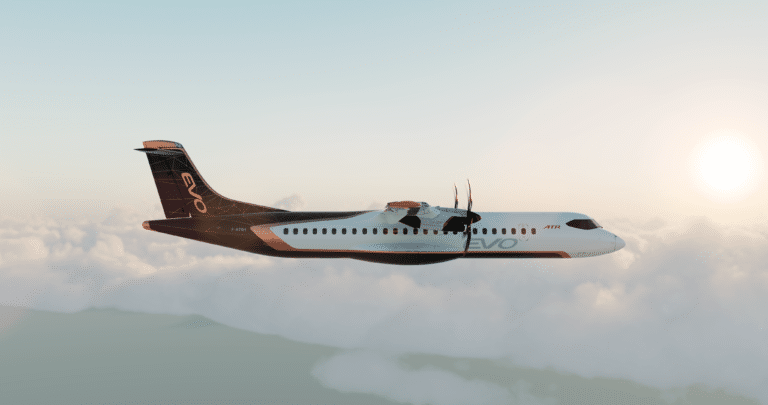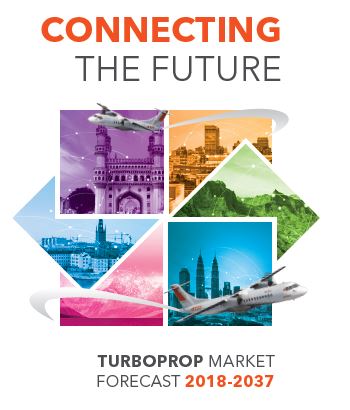ATR sees demand for 3,000 new turboprops valued at over US$ 80 Billion over the next 20 years
– Growing regional connectivity, at the basis of the positive outlook
– ATR estimates a potential for 2,770 new routes
– 30% of the regional traffic by 2037 will come from routes which do not yet exist
– Turboprops remain the most eco-efficient solution for regional aviation
– ATR sees also increasing demand for turboprops in the cargo market
The key driver for this positive outlook is traffic growth in regional connectivity. This comes from both traditional markets where less connected locations are being connected with direct regional new routes, as well as from emerging markets where the most viable solution for connecting people and transporting goods is turboprop air links.
In the 2018-2037 market forecast, nearly 80% (2,390 aircraft) of the total demand is expected to come from the 61-80 seat category, a market segment served for years by the ATR 72. The remaining 20% (630 aircraft) will come from the 40-60 seat market, a segment where the ATR 42, the only 50-seat aircraft available new on the market, provides strong potential for the up gauge of 30-seat, and the replacement of 50-seat, regional aircraft.
Over the next 20 years, the largest demand for turboprops is expected to come from Asia (43%), followed by Europe, Africa and Middle East (31%) and the Americas (26%).
Beyond passenger aircraft, ATR estimates that the increase of freight traffic will generate, over the next two decades, a potential for the delivery of 460 turboprop freighters. This includes converted aircraft as well as the recently launched ATR 72-600F, the only regional cargo aircraft available straight from factory.
There are several drivers that can explain the expected high demand for turboprops
Route creation & traffic growth
Regional aviation has experienced an outstanding development, with 58% of the current regional networks worldwide having been created over the last 15 years. The growth of the regional routes has been particularly intense in the period 2012 – 2017, with ATR playing a major role, with an annual average of over 100 new routes created, and a record of 155 new routes in 2017. Today, turboprops operate half of the flights below 330 nm all over the world, the most fuel-efficient solution for short-hauls. ATRs are particularly reputed for their eco-efficiency, featuring a fuel consumption of up to 45% less than regional jets and 30% less than competing turboprop.
Based on their current and recent success in opening new routes with the lowest risk, ATR estimates that turboprop aircraft have the potential to generate 2,770 new routes in the 20 years to come. During this period, regional traffic is expected to grow annually at a pace of 4.5%, with around 30% of the traffic in 2037 coming from routes that do not currently exist.
Connectivity & Social Responsibility
Air connectivity plays an essential role in boosting local economies. An increase in flights of 10% generates additional increases of 5% in tourism, 6% in regional GDP and 8% foreign direct investment. ATR, as the global benchmark among regional aircraft, will therefore play a major role in supporting social development. Turboprops are key in connecting communities around the world: 36% of all commercial airports rely exclusively on turboprops and 50% rely, also exclusively, on regional aircraft.
ATR is already renowned for its eco-efficiency. When compared to an equivalent-sized regional jet, a latest generation ATR emits up to 40% less CO2. Turboprops will continue to play an essential role in minimising the impact on the environment. If all operating regional jets were to be replaced by turboprops in routes up to 500 nm, regional aviation would reduce overall CO2 emissions by 11%. In addition, often serving urban airports, the significantly lower noise footprint of ATRs, further contributes towards their social responsibility.
Innovation in turboprop technology with new versions & Digital Services
The ability to continuously innovate to match market requirements will also be essential to the demand for new turboprops over time. ATR has a good track record in this domain. Besides the recent launch of the new ATR 72-600F freighter version, ATR evaluates a version of the ATR 42-600 with enhanced performance at take-off and landing, thus potentially expanding accessibility and opening new routes and markets. The turboprop manufacturer will also expand operational versatility with the new ClearVision system, a first in commercial aviation, currently under certification, that enhances pilot visibility and awareness. The expansion of customer support and services, along with their progressive digitalisation, will also continue to play a key role in the success of turboprops in the years to come. Today, with an in-service fleet of over 1,100 aircraft, ATR’s services revenue represents some 20% of the total turnover, and is expected to grow by 10% annually.
The new ATR Market Forecast is available at the ATR website:
http://www.atraircraft.com/newsroom/download-center.html
Download PDF
Press Contacts
Charlotte Giuria
Media ManagerJeanne Caumont
Content & Media RelationsAbout ATR
ATR is the world number one regional aircraft manufacturer with its ATR 42 and 72, the best-selling aircraft in the below 90-seat market segment. The unifying vision of the company is to accelerate sustainable connections for people, communities and businesses, no matter how remote. Flown by some 200 airlines in over 100 countries, ATR aircraft open 120 new routes on average every year, facilitating the development of territories and enabling access to crucial services like healthcare and education. Thanks to ATR’s focus on continuous innovation and the intrinsic efficiency of the turboprop technology, ATR aircraft are the most advanced, versatile, cost-effective and lowest-emission regional aircraft on the market, emitting 45% less CO2 than similar-size regional jets. In January 2022, we flew the first ever commercial aircraft using 100% SAF in both engines. ATR is a joint-venture between Airbus and Leonardo.











